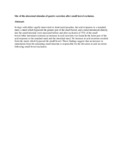| dc.contributor.author | Buxton, B | |
| dc.contributor.author | Wasunna, AE | |
| dc.contributor.author | Saunders, J | |
| dc.contributor.author | Gillespie, IE | |
| dc.date.accessioned | 2013-05-30T07:24:43Z | |
| dc.date.available | 2013-05-30T07:24:43Z | |
| dc.date.issued | 1972-07 | |
| dc.identifier.citation | Gut. 1972 Jul;13(7):539-43 | en |
| dc.identifier.uri | http://www.ncbi.nlm.nih.gov/pubmed/5069730 | |
| dc.identifier.uri | http://erepository.uonbi.ac.ke:8080/xmlui/handle/123456789/27384 | |
| dc.identifier.uri | http://www.ncbi.nlm.nih.gov/pmc/articles/PMC1412278/ | |
| dc.description.abstract | In dogs with either vagally innervated or denervated pouches, the acid responses to a standard meal, a meal which bypassed the greater part of the small bowel, and a meal introduced directly into the small intestine were measured before and after exclusion of 75% of the small bowel.After intestinal exclusion an increase in acid secretion was found in the latter part of the acid response to the standard meal and the intestinal meal. No increase in acid secretion resulted from the meals which bypassed the small bowel. These findings suggest that an increase in stimulation from the remaining small intestine is responsible for the elevation in acid secretion following small bowel exclusion. | en |
| dc.language.iso | en | en |
| dc.publisher | University of Nairobi | en |
| dc.title | Site of the abnormal stimulus of gastric secretion after small bowel exclusion. | en |
| dc.type | Article | en |
| local.publisher | School of medicine | en |

